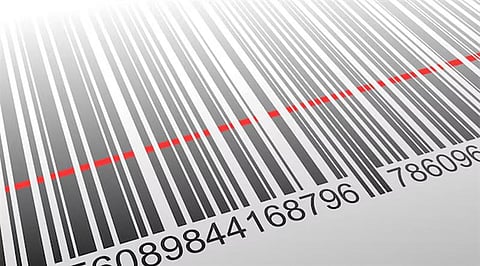

Choosing a barcode scanner may seem acceptable at first sight. After all, isn't scanning just scanning? But offer a little more profound thought, and you'll feel the ripple effect all across your operations. The right scanner can speed up workflows, reduce errors, and ease working conditions for everyone else in the team. The wrong one hangs in there by a slowdown trigger and headache generator, costing would-be money in time later.
Managing inventory, asset tracking, or process simplification requires judging the 1d vs 2d barcode scanner. Let's break it down with something understandable to every business.
These 1D barcodes, the lines most commonly seen on products at stores, encode information in a series of vertical lines and spaces. Simple, straightforward, and easy to scan.
If you have scanned groceries or received a shipment at a warehouse, you have worked with 1D barcodes. They are quick, cheap, and highly dependable. Whenever there is competent scanning for product IDs, inventory levels, or simply checking things off a list, 1D scanners will do.
The disadvantage is that the 1D barcode type can sometimes carry less information; normally, just a product or serial number. Stick to 1D linear codes if you wish to store the entire data set, such as batch numbers, expiry dates, or links to digital records.
Imagine a retail store scanning hundreds of items at checkout. A 1D scanner zips through the process with no delays. Now imagine trying to encode detailed manufacturing info or asset history into those same barcodes; 1D would struggle. That's where 2D scanners come into play.
More sophisticated in look, so-called matrix codes were never meant to be hidden away. Usually, one finds QR codes splattered on product labels, tickets, and outdoor advertisements- they go wherever they are of value. A curious mind would ask, how can something so small hold such huge information?
2-D barcodes encode data in both the horizontal and vertical directions. That means it can be text, URLs, serial numbers, or even images. These codes can be great for tracking purposes when businesses require a lot of detail or need to jump right into digital information.
Unlike 1D scanners that swipe the laser across the barcode in a straight line, 2D scanners actually snap a snapshot of the entire code. It reads the code from various angles and distances, even against surfaces that are not perfectly flat. This is especially useful in healthcare, logistics, and manufacturing systems that require timing with precision.
Sure enough, 2D scanners do cost a little more and can be a bit slower to scan. But more often than not, the amount of information one can get from a single scan makes the investment worth it. If every bit of information matters, get yourself a 2D scanner!
Consider 1D as a sprinter and 2D as a decathlete. One can only do something quick and easy; the other is versatile and skilled to tackle more complex problems.
Conducting a side comparison:
1D Barcode: Quick, simple, and it will scan small amounts of data. Great for fast-paced environments.
2D Barcode: Makes available rich information content; it is flexible concerning scanning, is capable of handling complex data, and can be utilized in diverse types of environments.
The decision does not lie in which is better, but in what your business actually requires.
1D Scanners excel in high-volume, simple scanning scenarios. Retailers, warehouses, and production lines benefit from their speed. Scan, move on, repeat.
2D Scanners shine when details matter. Hospitals can track instruments and patient records. Logistics companies can monitor shipments from start to finish. Manufacturing plants can follow each component through assembly with precision.
Even within the same organization, you might need both. Quick inventory scans in a warehouse could rely on 1D scanners, while tracking high-value assets or detailed product information could require 2D scanning.
A distribution center receives thousands of packages daily. Standard products with barcodes get scanned in seconds using 1D scanners. Specialty items with embedded batch info, customer details, or serial numbers are scanned using 2D scanners. Both systems coexist, keeping operations smooth.
Here's a practical guide to deciding which scanner fits your needs:
Data Depth: Ask yourself, how much information needs to be captured per scan? Small inventories might only need 1D. Complex asset tracking likely requires 2D.
Environment: Lighting, distance, surface material, all impact scanner performance. 2D scanners handle difficult conditions better.
System Compatibility: Ensure the scanner integrates seamlessly with your current software, like ERP or inventory management systems.
Cost vs. Benefit: Factor in both upfront costs and long-term efficiency gains. The cheapest option isn't always the most cost-effective.
A little planning goes a long way. Choosing the right tool ensures the scanner works for your team, not against them.
Barcode scanning is in the process of being upgraded by modern technologies. Modern scanners can interact with the IoT system for real-time inventory updates, for example, reducing errors, making quicker decisions, and better understanding your operations.
Regardless of the increasingly new and emerging technologies, the 1d vs 2d barcode scanner must still be known. This means that choosing the right scanner today will set you up for smarter workflows in the future.
A 1D scanner is fairly well-suited for fast and simple applications. On the other hand, a 2D scanner really shines in richer data scenarios and complicated tracking. There is room for both, and thoughtful use of either can lead to an improvement in efficiency.
If your scanner is right for your workflow and data requirements, then your team stays productive, operations keep on track, and business stays smooth. Making the right choice today will make life easier later on, and that is always worth a few points.
